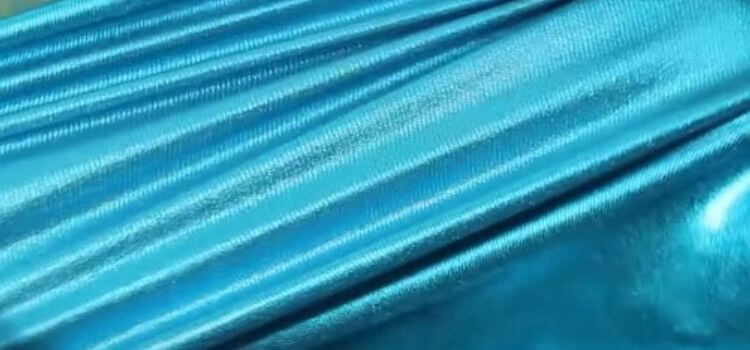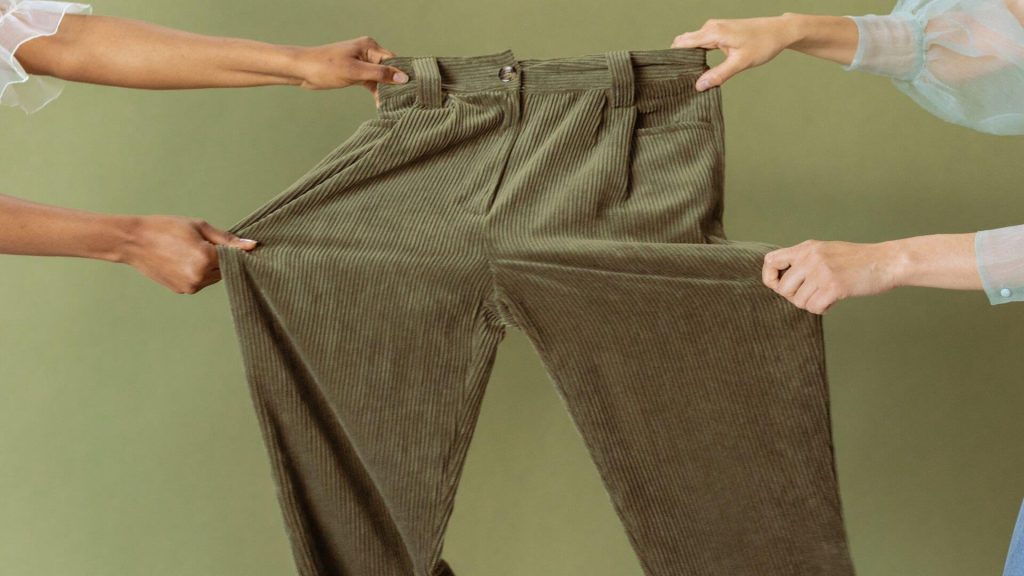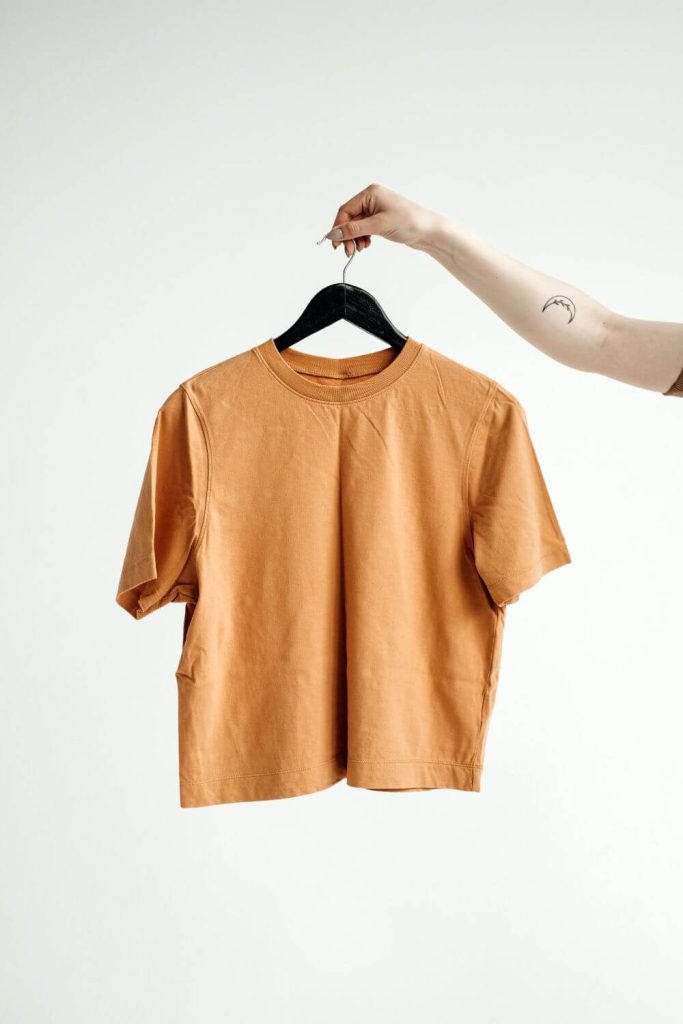If you buy via any of our links, there will be no additional cost to you, and we will receive a tiny commission. More information is available on our Affiliate Disclosure page.

Is Polyester Stretchy?
Polyester is stretchy, when and how? Polyester gains the ability to stretch when mixed with spandex. The higher the amount of spandex mixed with the polyester, the higher the expansion capacity will be.
Polyester can be a stretchy knit fabric made by looping yarn together, and the type of loop that is used can affect the stretchiness of the fabric. Another can make the polyester fabric weak because it is a special finishing technique that requires heat.
However, one question that often arises is whether is polyester stretchy? While polyester is not as stretchy as fabrics like spandex or elastane, it can still have a certain amount of flexibility and give. This is especially true when polyester is combined with other stretchy fibers like spandex.
Understanding the stretchiness of polyester can help in selecting the right size and fit for clothing items made from this fabric. We will explore the stretchiness of polyester and its implications for garment fit and comfort.
Again, you must thinking that “is polyester stretchy?“
This stretchy fabric finds extensive usage in bodycon dresses, leggings, sports bras, swimsuits, and activewear. However, when blended with spandex, polyester becomes a popular choice for clothing items.
Polyester does not stretch when knitted first, but with new weaving techniques, textile specialists have created polyester 100% stretchy fabric.
Factors That Affect Stretch In Polyester
Are you familiar with polyester? It’s actually a quite fascinating fabric! Not only is it incredibly durable, it’s also wrinkle-resistant. This makes it a popular choice for clothing and household items that need to stand up to wear and tear.
While polyester can stretch to some extent, it is not as stretchy as fabrics like spandex or elastane. The stretchiness of polyester material depends on various factors, including:
Blending With Elastane Or Spandex
Blending polyester with elastane or spandex can significantly enhance its stretchiness. Elastane and spandex fibers have excellent elasticity, which allows the fabric to stretch and recover its original shape. When polyester is blended with elastane or spandex, it gains stretch properties while still benefiting from the durability and shape retention of polyester. This makes such blends ideal for clothing items that require flexibility, such as athletic wear or underwear.
Fabric Construction
The construction of the fabric also plays a role in determining its stretchiness. Fabrics with a tighter weave or knit tend to have less stretch, while looser weaves or knits can provide more stretch. Polyester fabrics with a looser construction can offer greater flexibility and stretch, allowing for comfortable movement. Additionally, different fabric finishes and treatments can affect the stretch of polyester. For example, brushed or peached finishes can increase the fabric’s softness and stretchiness.
Fiber Treatment
The treatment applied to polyester fibers can influence their stretch properties. Some polyester fabrics undergo special treatments to enhance their stretchiness, such as mechanical or chemical stretching processes. These treatments help break down the molecular structure of the polyester fibers, allowing them to stretch more easily.
However, it’s important to note that the stretch achieved through fiber treatment may not be as long-lasting as the stretch offered by blending with elastane or spandex.
The stretchiness of polyester fabric is influenced by factors such as blending with elastane or spandex, fabric construction, and fiber treatment. By considering these factors, you can choose polyester garments that provide the desired level of stretch and comfort.

Comparing Polyester Stretch To Other Fabrics
When it comes to determining the stretchiness of fabrics, it’s important to compare them to one another. Polyester, while it can stretch to some extent, falls short of the stretchiness found in fabrics like spandex or elastane.
Let’s take a closer look at the stretching capabilities of spandex and elastane compared to polyester.
It’s Not As Stretchy As Fabrics Like Spandex Or Elastane
Polyester is a synthetic fabric known for its durability, shape-retaining properties, and resistance to wrinkles and shrinkage. While polyester can stretch to accommodate movement, it’s not as stretchy as fabrics like spandex or elastane.
Spandex, also known as Lycra or elastane, is a highly stretchable and elastic fabric commonly used in activewear, swimwear, and form-fitting garments. Elastane offers excellent stretch and recovery, making it ideal for body-hugging clothes.
Stretching Capabilities Of Spandex And Elastane Compared To Polyester
Spandex and elastane are highly elastic materials that can stretch up to 500% of their original length, quickly returning to their original shape once released. On the other hand, polyester typically has a lower stretchability, ranging from 10% to 25% of its original length.
While polyester’s stretch may be limited, it offers benefits such as shape retention, durability, and resistance to fading and wrinkling.
When it comes to choosing the right fabric for your clothing needs, it’s essential to consider the level of stretch required. If you’re looking for a fabric with maximum stretch and elasticity, spandex or elastane would be the ideal choice.
However, if you prefer a fabric that offers moderate stretch along with other desirable qualities like durability and shape retention, polyester can be a great option.
While polyester can stretch to some extent, it falls short of the stretchiness found in fabrics like spandex or elastane. If you’re in need of a fabric with superior stretch and elasticity, consider opting for spandex or elastane.
However, if you require a fabric that offers a balance between stretch and other beneficial properties, polyester can be a suitable choice for various clothing items.
The Different Types Of Polyester Blends
When it comes to clothing materials, polyester is a popular choice due to its durability, wrinkle resistance, and easy maintenance. However, many people wonder, “Is polyester stretchy?” The answer to that question depends on the type of polyester blend being used.
Let’s take a closer look at the different polyester blends available and how they compare to other materials.
Polyester Vs. Polyester Blends
Polyester fabrics are made from synthetic fibers that are derived from petroleum. They are known for their strength and resistance to shrinkage and wrinkles. However, pure polyester fabric is not very stretchy. To add stretchability to polyester, it is often combined with other fibers, such as elastane or spandex, to create polyester blends.
Polyester Vs. Spandex (elastane)
Spandex, also known as elastane, is a highly stretchable synthetic fabric. When polyester is blended with spandex, it gains the stretch and elasticity that polyester lacks on its own. This blend is commonly used in athletic wear, activewear, and tight-fitting clothing items where stretchiness is desired.
Polyester Vs. Nylon
Nylon is another synthetic fabric that is commonly used in clothing. While polyester and nylon are similar in terms of their strength and durability, nylon is known to be more stretchy compared to polyester. However, polyester is often preferred over nylon in certain applications due to its resistance to fading and wrinkle-free properties.
Polyester-rayon
Polyester-rayon blends are commonly used in various types of clothing, including shirts and dresses. The combination of polyester and rayon creates a fabric that is soft, lightweight, and has a moderate amount of stretch.
While pure polyester fabric is not very stretchy, polyester blends can offer varying degrees of stretchability depending on the other fibers they are combined with. By blending polyester with materials like spandex or elastane, you can create fabrics that offer the durability of polyester with the added stretchiness.
Whether you’re looking for athletic wear with maximum stretch or a comfortable and slightly stretchy everyday garment, understanding the different types of polyester blends can help you make an informed decision.

Examples Of Stretchy Polyester Fabrics
Polyester is a versatile fabric that is commonly used in various types of clothing and textiles. While it may not be as stretchy as fabrics like spandex or elastane, polyester can still provide a certain level of stretch and flexibility. In this section, we will explore a few examples of stretchy polyester fabrics and what makes them suitable for different applications.
Polyester Jersey
Polyester jersey is a type of knitted fabric that offers a great combination of stretch and durability. It is commonly used in a wide range of garments, such as t-shirts, dresses, and athletic wear. The stretch in polyester jersey allows for comfortable movement and ensures a snug fit that retains its shape even after multiple washes. Its wrinkle-resistant properties make it a popular choice for travel-friendly clothing.
Polyester Fleece
Polyester fleece is a soft and cozy fabric that is widely used in jackets, sweaters, and blankets. This fabric provides a good amount of stretch, allowing for ease of movement. Polyester fleece is known for its excellent insulating properties, making it perfect for cold weather clothing. Its stretchy nature also ensures a comfortable fit without compromising on warmth.
Polyester Spandex Blend
A polyester spandex blend combines the best of both worlds – the durability of polyester and the exceptional stretch of spandex. This blend is commonly used in sports and activewear, as well as in loungewear and underwear. The stretchiness of the spandex component provides the necessary flexibility for optimal performance in athletic activities. It also enhances the overall comfort and fit of the garment.
Overall, while polyester may not be as stretchy as some other fabrics, it still offers a certain level of flexibility and is suitable for a variety of applications. Whether it’s polyester jersey, polyester fleece, or a polyester spandex blend, these fabrics provide the desired stretch and durability for different types of clothing and textiles.

Polyester In Fashion And Apparel
Polyester is known for its shape-retaining properties, but it is not as stretchy as fabrics like spandex or elastane. Sizing up in polyester garments is usually unnecessary, as the fit is influenced by factors like fabric blend, cut, and design.
Usage In Sports And Activewear
When it comes to sports and activewear, polyester is a go-to fabric due to its unique properties. The durability, lightweight, and moisture-wicking nature of polyester make it a popular choice among athletes. Its ability to quickly dry and its resistance to shrinkage and wrinkles make it ideal for rigorous physical activities. Additionally, polyester is often blended with other fabrics such as spandex to enhance its elasticity and provide better flexibility.
Advantages For Form-fitting Designs
Polyester fabric flexibility and its moldable nature make it an excellent choice for form-fitting designs. Its ability to stretch and conform to the body allows designers to create garments that accentuate the wearer’s figure. Polyester’s stretchiness ensures a snug fit without compromising on comfort and freedom of movement. Moreover, the fabric’s shape-retaining properties ensure that the garment maintains its form even after repeated wear and washing.
Polyester’s Role In Performance Wear
When it comes to performance wear, polyester plays a crucial role in providing the necessary qualities required for intense physical activity. Polyester-based textiles offer a combination of durability, moisture-wicking capabilities, and breathability, making them an ideal choice for athletes and active individuals. Let’s explore some of the innovations in polyester-based textiles that have revolutionized the performance wear industry.
Innovations In Polyester-based Textiles
Polyester has come a long way since its inception and continues to evolve with advancements in textile technology. These innovations have led to the creation of fabrics that go beyond the limitations of traditional polyester. Here are some notable innovations:
Moisture-wicking technology:
Performance wear garments made with moisture-wicking polyester fibers are designed to pull sweat away from the skin, keeping the wearer dry and comfortable during intense workouts or outdoor activities. The moisture-wicking properties of polyester allow for efficient evaporation, preventing the build-up of moisture and reducing the risk of chafing.
Elasticity in polyester textiles:
While polyester alone may not be as stretchy as spandex or elastane, advancements in textile engineering have resulted in the creation of polyester blends that offer enhanced flexibility and elasticity. The incorporation of stretch fibers like spandex or elastane into polyester-based fabrics allows for greater freedom of movement, making them suitable for garments that require stretch and recovery, such as yoga pants or compression gear.
Antibacterial properties:
Polyester-based textiles can now be treated with antibacterial finishes that inhibit the growth of odor-causing bacteria. This is particularly beneficial for performance wear garments that are worn for extended periods, as it helps to keep them fresh and odor-free even during intense workout sessions.
Ensuring Polyester’s Role In Performance Wear
Manufacturers and designers continuously strive to improve polyester-based textiles for performance wear. Factors such as fabric blend, garment cut, and design all play a crucial role in determining the performance properties of polyester garments.
By carefully considering these aspects, performance wear can offer the necessary attributes required for optimal comfort, durability, and performance.
Summing it up, polyester has become a staple in performance wear due to its ability to provide durability, moisture-wicking capabilities, and breathability. With advancements in textile technology, polyester-based fabrics now offer enhanced flexibility, elasticity, and antibacterial properties.
This makes them a top choice for athletes and active individuals who require garments that can withstand intense physical activity while keeping them comfortable and fresh.
Benefits Of Stretchy Polyester
Stretchy polyester is a versatile fabric that offers comfort, durability, and convenience. Its unique properties make it an ideal choice for various applications, including activewear and loungewear. Let’s dive deeper into the benefits of stretchy polyester.
Comfortable To Wear
Stretchy polyester provides flexibility and movement with the body, ensuring a comfortable wearing experience. The fabric has a slight stretch that allows it to adapt to body movements without constriction or discomfort. Whether you’re engaging in physical activities or simply lounging around, the comfort provided by stretchy polyester is unparalleled.
Shape-fitting
One of the standout qualities of stretchy polyester is its form-fitting properties. The fabric contours and molds to your body shape, creating a flattering and streamlined silhouette. This is especially beneficial for those who want to showcase their curves or prefer a more fitted look. Whether it’s a dress, pants, or activewear, stretchy polyester provides a stylish and flattering fit.
Durable
Stress the resilience of stretchy polyester. This one is tough enough to withstand all your adventures, and still come out looking great. Say goodbye to flimsy fabrics and welcome your new go-to for everyday wear and tear. Unlike other materials that may lose their shape or integrity over time, stretchy polyester maintains its quality and strength. This durability ensures that your garments will last longer, providing excellent value for your investment.
Wrinkle-resistant
Another advantage of stretchy polyester is its wrinkle-resistant nature. With this fabric, you can say goodbye to garment creases and ironing headaches. The elasticity in stretchy polyester helps it bounce back to its original shape, even after being folded or packed. This reduces the need for ironing, enhancing convenience and saving you precious time in your daily routine.
Drawbacks Of Stretchy Polyester
Polyester fabric is not as stretchy as materials like spandex or elastane. While it does have some shape-retaining and slight stretch properties, sizing up in polyester clothing is typically unnecessary. The level of stretch in polyester garments is influenced by factors such as fabric blend, cut, and design.
Less Breathable
Polyester, although it has many benefits, is known to be less breathable compared to natural fabrics like cotton or linen. This lack of breathability can be a drawback, especially in hot weather or during physical activities. The synthetic nature of polyester restricts airflow, causing moisture to trap against the skin. Feeling uncomfortable and sweating excessively can be a real hassle.
Environmental Impact
The production of polyester has significant implications for the environment. Polyester is derived from petrochemicals and involves an energy-intensive manufacturing process. The extraction and refining of petroleum, along with the chemical treatments needed to turn it into polyester, contribute to air pollution and water contamination.
In addition, polyester is not biodegradable, which means it accumulates in landfills and oceans, posing environmental threats. When polyester garments eventually end up as waste, they take hundreds of years to break down, contributing to the global issue of single-use plastics.

Care Tips For Stretchy Polyester
Polyester is not as stretchy as fabrics like spandex or elastane. However, if blended with spandex, it can provide some stretch, making it suitable for athletic wear and underwear. Sizing up in polyester is usually unnecessary, as the fit is influenced by fabric blend, cut, and design.
Best Practices For Maintaining Elasticity
Proper care is essential for maintaining the elasticity of your stretchy polyester garments. By following these best practices, you can keep your clothes looking and feeling great for a long time:
Wash with cold water
When it comes to stretchy polyester, hot water can be damaging. Use cold water to prevent the fabric from losing its elasticity.
Gentle cycle
Opt for a gentle or delicate cycle when washing your stretchy polyester garments. This will minimize any unnecessary stretching or pulling of the fabric.
Use a mild detergent
Harsh chemicals in some detergents can weaken the fibers of your polyester garments, resulting in loss of elasticity. Choose a mild, gentle detergent to preserve the fabric’s stretchiness.
Do’s And Don’ts In Washing And Drying
Knowing the do’s and don’ts of washing and drying your stretchy polyester is crucial for maintaining its elasticity and overall condition. Check out these tips that will help you stay on track and succeed!
Do:
Turn the garment inside out:
This simple step can help protect the fabric’s surface from friction and potential damage.
Use a laundry bag:
To further safeguard your polyester garments, place them in a mesh laundry bag before washing.
Hang dry:
Air drying is the best option for stretchy polyester. Hang your garments on a clothesline or drying rack to avoid heat damage from the dryer.
Don’t
Use bleach
Bleach can weaken and degrade the fibers of your stretchy polyester, causing it to lose its elasticity and color. Avoid bleach at all costs.
Overdry in the dryer
Overdrying in the dryer can lead to shrinkage and loss of stretch in your polyester garments. Remove them from the dryer while still slightly damp to prevent this.
Wring or twist
Avoid wringing or twisting your stretchy polyester garments when washing or drying. This can cause stretching and affect the fabric’s elasticity.
The Future Of Stretchable Polyester
As technology continues to evolve, the future of stretchable polyester looks promising. Research and development are ongoing to create even more advanced and functional stretchable polyester fabrics. With the combination of innovative fiber blending, sustainable practices, and cutting-edge weaving techniques, polyester garments with superior stretchability and comfort are expected to become more readily available in the market.
The future of stretchable polyester is bright and filled with exciting possibilities. As the demand for comfortable and flexible clothing continues to rise, the textile industry is responding with advancements in fiber technology. Through blending with elastic fibers and sustainable manufacturing processes, stretchable polyester is becoming a popular choice for various clothing items, including athleisure wear and underwear. With further innovations on the horizon, we can expect to see even more impressive stretchable polyester fabrics in the future.
Polyester is not as stretchy as fabrics like spandex or elastane, but it does have some give. Sizing up in polyester is usually unnecessary due to its shape-retaining properties, but the fit of a polyester garment is influenced by factors like fabric blend and design.
Trends And Advancements In Fiber Technology
With the growing demand for stretchable fabrics, the textile industry is constantly striving to innovate and develop new materials. Advancements in fiber technology have played a significant role in the future of stretchable polyester. Polyester itself is not naturally stretchy, but through various manufacturing processes, it can be transformed to possess stretchy properties.
Improving Polyester’s Stretchability
Manufacturers have been working on enhancing and improving the stretchability of polyester. One method involves blending polyester with other elastic fibers such as spandex or elastane. This combination creates a fabric that can stretch and recover, offering flexibility and comfort. Additionally, the use of high-quality microfibers and the development of new weaving techniques have also contributed to enhancing polyester’s stretchability.
The Rise Of Sustainable Stretchable Polyester
With the increasing emphasis on sustainability and eco-friendly practices, the textile industry has also been focusing on developing sustainable stretchable polyester. Innovations like the use of recycled polyester fibers and the implementation of environmentally friendly production processes are actively being explored. These efforts aim to reduce the environmental impact of polyester production while maintaining its stretchable properties.
How to Stretch Polyester Clothes?
Stretching polyester clothes can help you get a better fit, especially if the garment is too tight or uncomfortable. While polyester has easy elasticity, here are several methods for stretching it and making it flexible to your body shape. Here are a few pointers and techniques:
Damp Stretching Method:
Wet the polyester garment until it is evenly moist but not soaked.
Stretch the damp fabric gently in the areas where you want more room or ease.
These will be completed by pulling the fabric or wearing the damp garment and gently stretching it around your body.
To keep your polyester garment in its stretched shape, dry it while it’s stretched out.
Steam Stretching Method:
Steam the polyester garment thoroughly by hanging it in a steamy bathroom or using a steamer.
Gently stretch the areas that require more space while the fabric is warm and moist from the steam.
Avoid overstretching or damaging the fabric. Take your time and apply gentle pressure to achieve the desired fit.
Allow the garment to air dry after steam stretching to maintain the new shape.
Wear and Stretch:
Simply putting on the polyester clothing for an extended period can help it conform to your body shape and stretch slightly.
Move around in the clothing and use gentle stretching movements that allow the fabric to adjust to your body.
Using Fabric Conditioner:
Soak the polyester garment in a mixture of water and fabric conditioner for at least 30 minutes.
Fabric conditioners can soften the fibers and make the fabric more stretchable.
After soaking, gently stretch the garment in the areas that require more space, and then air dry it.
Use a Fabric Stretcher:
Fabric stretchers are tools designed specifically for stretching clothes.
To avoid damaging the garment, follow the instructions with the fabric stretcher.
You’ll need to secure the garment on the stretcher and gradually increase the tension until you achieve the desired stretch.
Consult a Professional Tailor:
If you have a polyester garment that needs significant alterations, it’s best to seek the help of a professional tailor.
A tailor can assess the garment accurately and make precise alterations to achieve the best fit.
When stretching, remember that too much force or stretching can cause fabric damage. Always start with gentle stretching and gradually increase the stretch until you achieve the desired fit. Using these techniques, you can make your polyester clothes more comfortable and enjoyable.
If you really need to do stretching fabric learn more from here.
Is it Good to Have Polyester in Jeans and Dresses?
Polyester behaves differently in different garments, like jeans and dresses, simply because of fabric construction, blend compositions, and finishing ways. Let’s look at how the stretchiness of polyester feels in these specific garments:
Polyester in Jeans:
When polyester is blended with other fibers in jeans, like cotton or elastane, the stretchiness can differ depending on the percentage of polyester used.
Jeans made out of a polyester/cotton blend tend to offer less stretch than those created with elastane or spandex.
In polyester-cotton blends, the polyester component can add some flexibility and increase durability, without sacrificing the classic, rigid appearance of the denim.
Jeans with a higher percentage of elastane or spandex provide superior stretch and comfort, allowing for a greater range of motion. These stretchy jeans are common “stretch jeans” and are popular due to their ease of wear and form-fitting silhouette.
Polyester in Dresses:
The stretchiness of polyester dresses varies depending on the type of polyester used and the design.
100% polyester dresses, particularly those with a woven construction, may have limited stretch and tend to be more structured and polished.
Knitted polyester dresses, particularly those blended with spandex or elastane, provide more stretch and flexibility, making them ideal for body-hugging silhouettes and draped designs.
Dresses made with polyester blends and other fibers like rayon, cotton, or elastane may have different amounts of stretch depending on the blend creation.
It’s worth noting that the perception of stretchiness in clothing is also affected by the fit and size chosen by the wearer. A garment that fits snugly may feel more stretchy with the fabric’s ability to conform.
The stretchiness of polyester in jeans and dresses depends on its chemical composition and design.
Jeans made from polyester-cotton blends may have some stretch, whereas those with elastane or spandex have more stretchy and comfortable.
100% polyester garments have a little stretch in dresses, whereas knitted polyester blends have more. Understanding how polyester behaves in different garment types aids in selecting the appropriate style and fit for many occasions and personal preferences.
Does Polyester Stretch When Wet or After Washing?
Polyester fabric is well-known for retaining shape and resisting stretching even when wet or after washing. Unlike natural fibers such as cotton, which can shrink or stretch when wet, polyester absorbs little water and retains its structure well.
Here are some of the reasons why polyester does not stretch when wet or after washing:
Low Water Absorption:
Polyester is a hydrophobic synthetic fiber that repels rather than absorbs water. This property keeps the fabric from becoming saturated with water, which can cause stretching or distortion. So when wet, polyester garments retain their shape and size.
High Resilience:
Polyester fibers are extremely pliable and resilient. They can tolerate the stress of washing and wearing without losing shape or stretching out. It makes polyester a more durable and long-lasting fabric, especially compared to natural fibers, which may stretch or shrink after washing.
Heat-Setting Process:
Fabrics made from polyester are frequently heat-set during the manufacturing process. This process aids in the stabilization of the fabric’s chemical makeup and ensures that it retains its shape even when subjected to external factors such as washing or moisture.
Drying Very Quickly:
The hydrophobic nature of polyester contributes to its quick-drying properties. Polyester garments dry relatively quickly after washing, reducing the time they are exposed to water and lowering the risk of stretching or distortion.
While polyester does not stretch when wet or after washing, it is important to follow proper care instructions to ensure the fabric’s integrity and longevity.
When washing or drying polyester garments, avoid too hot water, as this can damage the fabric and reduce its stretch resistance. Consider using a gentle cycle and cold or lukewarm water, besides airdrying or a low heat setting on the dryer.
Polyester is thus a practical choice for clothing and textiles that require durability and shape retention, especially in environments with frequent moisture exposure.
Polyester fabric’s low water absorption, high resilience, and heat-setting process contribute to its ability to resist stretching when wet or after washing.
Does Polyester Run Small or Big?
Polyester garment sizing and fit can vary depending on several aspects, involving the specific garment design, fabric blend, and the brand’s manufacturing standards.
Polyester, a synthetic fabric, lacks the stretch of materials like spandex, which can affect how it fits on the body. Here are some important factors to consider when selecting polyester garments in terms of sizing:
Brand and Manufacturer:
Sizing guidelines and fit preferences may vary between brands and producers. Before making a purchase, it is imperative to consult the brand’s size chart. While some brands might make clothes that fit more loosely or comfortably, others might make them more form-fitting.
Style and Design:
The style and design of a garment can have an impact on how it fits on the body. A flowy dress or blouse may have a more forgiving fit than a tailored jacket or body-hugging. When deciding on a size, keep the intended style and silhouette of the garment in mind.
Blended Fabrics:
When the polyester clothing is part of a blend with other fibers, like cotton or elastane (spandex), stretch and fit may be affected. A polyester-spandex blend can expand and have more flexible than 100% polyester.
Cut and Construction:
The cut and design of the garment can affect how it fits. Garments with darts, seams, or shaping panels are more likely to be tailored, whereas those with a simpler construction may be more relaxed.
Body Shape:
When selecting a size, consider your body shape and proportions. Some styles may be more flattering on certain body types, so finding a fit that complements your figure is critical.
Read Reviews:
When shopping online, reading customer reviews help you figure out how a garment fits and whether it runs large or small. Actual buyer experiences can provide valuable insights into the sizing of a specific item.
Measurements:
For your size, compare the brand’s size chart with your body metrics. For a comfortable and fitting garment, follow key measurements such as bust, waist, hips, and inseam.
Polyester garment fit and sizing can vary depending on the brand, style, fabric blend, and construction. To make an informed decision, consult the brand’s size chart, consider the garment’s design and body shape, and read reviews.
It allows you to find polyester garments that are both comfortable and flattering for your specific preferences and body type.
Does Polyester Stretch Out Over Time?
Comparing to natural fibers such as cotton, polyester fabric is known for its ability to retain shape and resist stretching.
Polyester can change with prolonged wear and use.
Let’s look at whether polyester stretches out over time:
Minimal Stretch:
100% polyester fabric has less stretch than materials such as spandex or elastane. This inherent property aids in the retention of shape and structure in polyester garments over time, even with repeated wear.
Shape Holding:
Polyester is a strong and long-lasting synthetic fiber. Even after continuous use, it is to resist stretching, sagging, and becoming baggy. The molecular structure of the fabric, as well as the heat-setting process used during manufacturing, contribute to its ability to retain its original shape.
Proper Fit Matters:
A well-fitted polyester garment will stretch and lose shape less over time. It should be a comfortable and flattering fit that is not so tight or loose.
Fabric Blends:
After polyester fabric blended with other fibers, like elastane or spandex, provide more stretch and flexibility. While this can improve comfort and ease of movement, it is hard to choose blends with the appropriate percentage of stretch fibers to prevent too much stretching over time.
Care and Maintenance:
Proper care and maintenance are essential for keeping the shape of polyester garments. Following the care instructions on the garment’s label, such as washing at the right setting and avoiding excessive heat during drying, helps to preserve the fabric’s quality.
Avoid Overstretching:
During wear, strong stretching of polyester garments can result in stretching out and distortion. While polyester is a strong material, excessive force can cause it to lose shape over time.
Polyester fabric is to resist stretching and keep its shape over time. Its low water absorption, high resilience, and heat-setting process all contribute to its capability to retain its original shape even after repeated use.
To keep polyester garments in good condition, choose the right fit, follow proper care instructions, and avoid excessive stretching while wearing.
Is 100% Polyester Good For You?
Wearing 100% stretchy polyester fabric can have both positive and negative effects.
Listed below is a more detailed look at the implications:
Comfort:
Because of its elasticity and flexibility, stretchy polyester fabric provides a comfortable fit.
Polyester’s stretchiness allows for freedom of movement, so it’s ideal for activewear, athletic clothing, and garments that require flexibility.
Polyester’s smooth texture contributes to overall comfort because it lacks the rough or abrasive feel like some other fabrics have.
Having Breathing Space:
One drawback of 100% stretchy polyester is its lack of breathability. Polyester has less breathability than organic materials like linen, cotton, and wool.
Polyester may not wick away moisture more effectively when perspiration is likely, such as during physical activities or hot weather, resulting in a less comfortable sensation.
Range of Motion:
The 100% polyester fabric’s stretchiness allows for a wide range of motion. It is ideal for activities involving bending, stretching, and dynamic movements.
Athletes, dancers, and people who practice yoga or exercise regularly prefer stretchy polyester garments for their freedom of movement.
Form-Fitting Silhouette:
It is in form-fitting clothing because of its ability to hug curves and contours.
While this can improve the appearance and create a sleek silhouette, it may not be the preferred style for everyone, as some people prefer looser or more relaxed fits.
Durability and Shape Retention:
The durability and shape retention of 100% stretchy polyester are well known. It does not stretch out or lose shape after frequent use and washing.
This longevity benefits the user by offering the garment’s fit and appearance over time.
Skin Acceptance:
Polyester fabric can lead to discomfort or irritation in some people with sensitive skin. Wearing a breathable layer or choosing blends with natural fibers can help to alleviate these issues.
Flexible and Versatility:
Stretchy polyester is a popular fabric for activewear, leggings, dresses, and undergarments simply because of its flexibility.
The capacity to provide ease and versatility while maintaining its shape makes it an ideal option for many events and activities.
Wearing 100% stretchy polyester fabric provides comfort, ease of movement, and a form-fitting silhouette. Its long-term wearability and shape retention are advantageous.
With sensitive skin, on the other hand, need to consider alternatives, and in situations where breathability is critical, blends with natural fibers may be preferred. Understanding the effects of stretchy polyester on the skin enables people to make more informed choices when purchasing clothing that meets their needs and preferences.
Frequently Asked Questions Of Is Polyester Stretchy
Is all polyester stretchy?
No, not all polyester is stretchy. Stretchiness can vary based on factors like fabric construction and blending with elastic fibers like elastane or spandex.
Can the stretchiness of polyester be increased permanently?
Yes, the stretchiness of polyester can be permanently increased through methods like blending with elastane or spandex during manufacturing or chemical treatments.
Is 100% Polyester Stretchy?
100% polyester is not very stretchy compared to fabrics like spandex or elastane. It has some shape-retaining and slight stretchiness, so sizing up is often unnecessary. The stretch of a polyester garment depends on factors like fabric blend, cut, and design.
Should You Size Up In Polyester?
Sizing up in polyester is usually unnecessary due to its shape-retaining and slightly stretchy nature. Polyester is not as stretchy as fabrics like spandex or elastane. Fit is influenced by fabric blend, cut, and design.
Is Polyester More Stretchy Than Cotton?
Polyester is not as stretchy as fabrics like spandex or elastane. However, when blended with stretchy fibers like spandex, it can become flexible and elastic, making it a popular choice for athletic wear or underwear. Sizing up is usually unnecessary due to its shape-retaining nature.
Is Polyester Skin Tight?
Polyester fabric is not skin tight. It lacks the stretchiness of fabrics like spandex or elastane. However, some polyester blends with spandex can offer a little give, making them suitable for clothing items like athletic wear or underwear
Conclusion
Polyester is a synthetic fiber with many benefits, including durability, versatility, and stretch. Often it is found in everything from athletic wear to form-fitting dresses. While polyester is not as breathable as natural fibers, it is a practical option for those seeking comfort and versatility.
Consider brand, style, body shape, and fabric blend when shopping for polyester clothing. Polyester can be combined with other fibers to achieve varying degrees of stretch and breathability.
Polyester is a valuable and long-lasting fabric in today’s diverse and ever-changing fashion landscape. We can enjoy the comfort and style it brings to our everyday wardrobes by understanding its properties and impact on the body.

